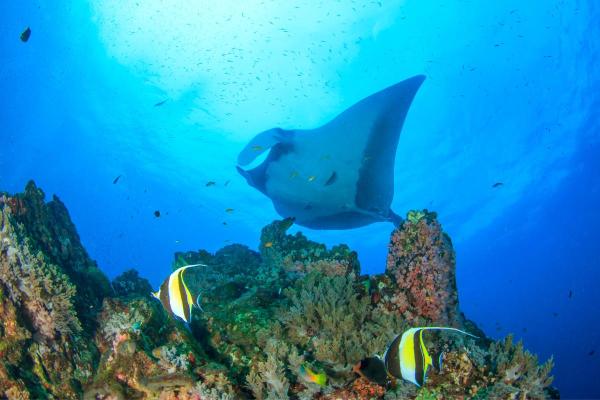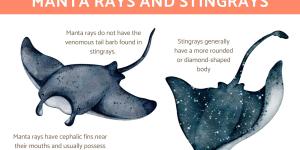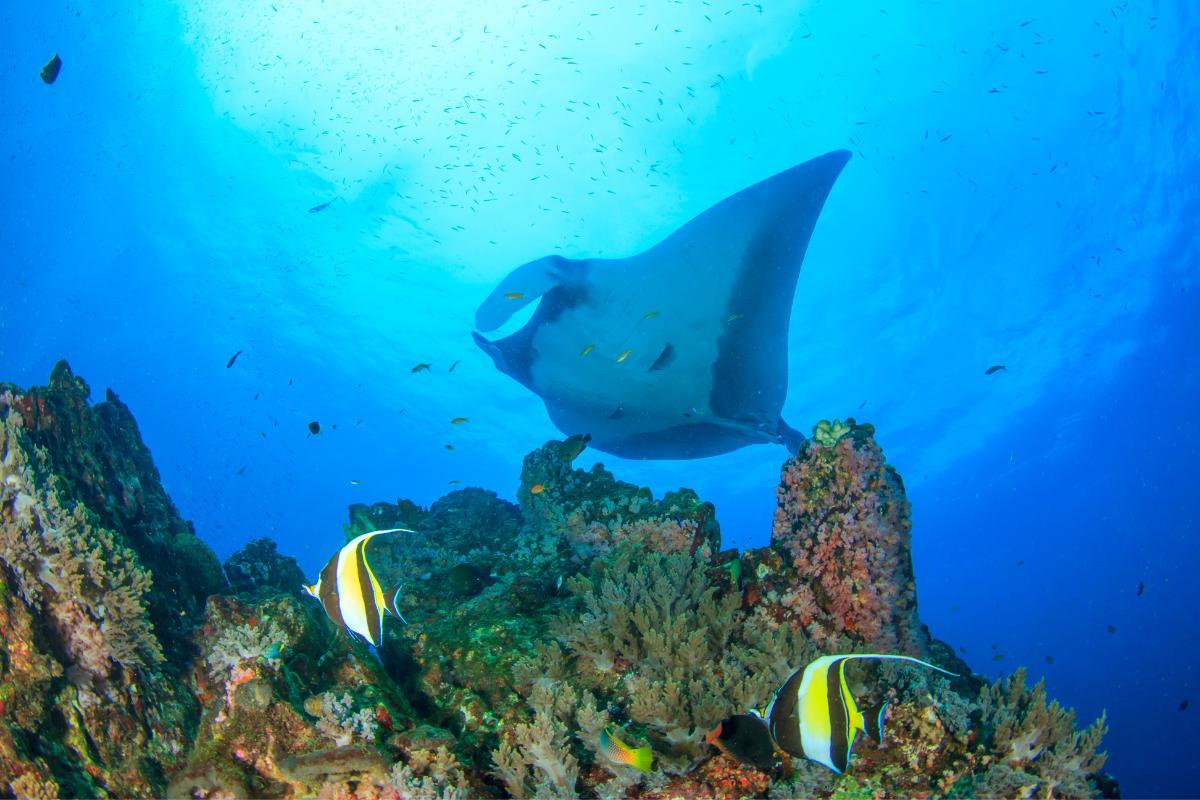Where Do Manta Rays Live In the World?


These gentle giants inhabit a variety of marine environments across the globe, from tropical coastal waters to the vast open ocean. These fish need specific conditions to thrive: temperatures above 20°C, abundant plankton for food, and clean waters for survival. Their choice of habitat shapes everything from their daily feeding patterns to their yearly migrations.
This AnimalWised article maps out where do manta rays live, highlights the best locations to find these marine giants, and delves into the reasons behind their habitat preferences.
Where do manta rays live?
Manta rays swim in warm ocean waters around the globe, favoring tropical and subtropical regions where temperatures stay above 20°C (68°F). Their habitat choices depend on several factors that affect their survival and comfort in these waters.
The reef manta ray (Mobula alfredi) lives near coral reefs, growing to 3-3.5 meters (9.8-11.5 ft) across. These rays stay in shallower waters, moving from the surface to depths of 120 meters (394 ft) as they search for food and rest.
Their larger relatives, the giant manta rays (Mobula birostris), prefer open ocean and coastal waters. At 4-7 meters (13-23 ft) across, they need more space to roam and often move between the surface and depths of 1,000 meters (3,281 ft) to find food and regulate their temperature. Spot the key differences between these two ray species.

Manta ray habitats
Manta rays select their habitats based on three specific environmental needs.
- Temperature drives their movement patterns. They prefer waters above 20°C and migrate when areas become too cool.
- Food location determines where they spend their time. Manta rays feed on zooplankton, so they gather where ocean currents create dense patches of these tiny organisms. Deep water upwellings and current meeting points act like natural feeding stations. These productive areas draw manta rays back to the same spots each season.
- Clean, clear water affects their feeding success and health. Good visibility helps them find food and spot dangers. You'll often find them in shallow coastal waters, lagoons, and bays where the water stays clean.
These habitat preferences create predictable gathering spots. These animals follow food-rich areas like island channels, continental shelf edges, and submarine canyons. During breeding seasons, they move to protected bays and shallow coasts, where their young have the best chance of survival.

Where to see manta rays?
You'll find manta rays in warm oceans around the globe, with each region offering different viewing opportunities. Their locations change with seasons, food availability, and breeding cycles.
Pacific Ocean
The Pacific Ocean provides some of the most accessible viewing spots. Hawaii's Kona Coast lets you watch resident manta rays feed at night, creating a unique spectacle as they glide through illuminated plankton.
Along Mexico's Sea of Cortez, seasonal gatherings bring large groups to the surface waters. Australia's Great Barrier Reef hosts year-round populations, while Japanese waters attract them in summer months.
Indian Ocean
In the Indian Ocean, the Maldives stands out for consistent sightings throughout the year. The waters here offer perfect conditions with abundant plankton and many cleaning stations.
Western Australia's Ningaloo Reef welcomes manta rays from April to November, and the Mozambique channel serves as a major migration route.
Atlantic Ocean's Caribbean Sea
The Atlantic Ocean's Caribbean Sea supports year-round populations. Brazil's coast sees seasonal visits, particularly when plankton blooms attract feeding groups. The waters near Africa's coast also draw manta rays when conditions align with their needs.
The best time to visit varies by location. The Maldives peaks from May to November, while Indonesia's Raja Ampat welcomes visitors year-round. Mexico's waters see most activity from November to May, and Australia's season runs April through November.
If you want to observe these creatures, follow some basic guidelines to protect them. Keep at least 3 meters (9ft) away, avoid using camera flash, and never attempt to touch or chase them. Your best option? Book tours with trained guides who understand manta ray behavior.

Protected areas where manta rays live
Conservation efforts are centered around several key marine reserves. These protected areas, which limit human activity while facilitating natural manta ray behavior, have proven effective. Each site encompasses feeding grounds, cleaning stations, and migration routes, all under official protection. Let's explore into the three most popular sites:
Baa Atoll Biosphere Reserve, Maldives
This UNESCO site hosts one of the biggest manta ray gatherings. Hanifaru Bay, inside the reserve, attracts hundreds of reef mantas during plankton blooms. The reserve limits daily visitor numbers and sets strict swimming rules. Local rangers monitor the area and guide tours to protect both mantas and their habitat.
Raja Ampat Marine Protected Area, Indonesia
Raja Ampat protects both reef and giant manta rays in its waters. The area's strong currents create perfect feeding conditions, while its reefs offer cleaning stations. Local laws ban fishing for mantas, and guides must follow specific approach guidelines. The protected area connects several key manta habitats, from deep ocean channels to shallow reef systems.
Revillagigedo National Park, Mexico
This Pacific park serves as a meeting point for giant manta rays. The park's remote location and complete fishing ban create a safe environment. Strong currents bring rich nutrients, making it a prime feeding site. Only licensed boats can visit, and all tours must follow strict viewing protocols. Scientists regularly study the mantas here, tracking their movements and behaviors.
Threats to manta ray habitats
Manta rays face mounting pressures in their ocean homes. These gentle filter-feeders need clean, warm waters rich in plankton to survive, but human activities increasingly threaten these conditions. Understanding these threats helps guide protection efforts for these marine animals and their habitats:
- Ocean acidification: poses a serious threat to manta rays by changing the basic chemistry of their habitat. As oceans absorb more carbon dioxide, the water becomes more acidic. This affects the tiny plankton manta rays eat. When plankton populations drop, manta rays must swim farther to find food, using more energy and risking exposure to new threats.
- Coastal development: brings multiple problems to manta ray habitats. New buildings, ports, and marine traffic increase underwater noise that can confuse these animals. Dredging and construction stir up sediment, which clouds the water and can clog their gills. These projects often destroy the shallow bays and coral reefs manta rays use for cleaning and breeding.
- Water pollution: comes in many forms, all harmful to mantas. Plastic waste can entangle them or block their digestive systems when they accidentally filter it with their food. Chemical runoff from farms and cities poisons their food chain. Oil spills coat their gills and can make it hard for them to breathe.
- Climate change: affects manta rays in several ways. Rising ocean temperatures force them to change their migration routes and feeding patterns. Changing currents disrupt the places where food normally concentrates. Stronger storms damage their reef habitats. These shifts make it harder for manta rays to find food and safe places to breed.
- Fishing: remains a problem even in protected areas. Some fishers still target manta rays for their gill plates, used in traditional medicine. Others accidentally catch mantas in nets meant for other fish. When fishing boats operate in manta feeding areas, they can separate mothers from their young or break up feeding groups.
After learning about their habitats, explore the diet of these creatures in our other article.
If you want to read similar articles to Where Do Manta Rays Live In the World?, we recommend you visit our Facts about the animal kingdom category.
- Harris, J.L., McGregor, P.K., Oates, Y., & Stevens, GM (2020). Gone with the wind: Seasonal distribution and habitat use by the reef manta ray (Mobula alfredi) in the Maldives, implications for conservation . Aquatic Conservation: Marine and Freshwater Ecosystems, 30(8), 1649-1664.
- Jaine, FR, Couturier, LI, Weeks, SJ, Townsend, KA, Bennett, MB, Fiora, K., & Richardson, AJ (2012). When giants turn up: sighting trends, environmental influences and habitat use of the manta ray Manta alfredi at a coral reef .
- Medeiros, AM, Luiz, OJ, & Domit, C. (2015). Occurrence and use of an estuarine habitat by giant manta ray Manta birostris . Journal of fish biology, 86(6), 1830-1838.
- Stewart, J.D., Nuttall, M., Hickerson, E.L., & Johnston, M.A. (2018). Important juvenile manta ray habitat at Flower Garden Banks National Marine Sanctuary in the northwestern Gulf of Mexico . Marine Biology, 165(7), 1-8.








